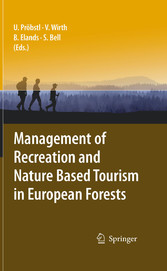Suchen und Finden
Service
Management of Recreation and Nature Based Tourism in European Forests
Ulrike Pröbstl, Veronika Wirth, Birgit H. M. Elands, Simon Bell
Verlag Springer-Verlag, 2010
ISBN 9783642031458 , 336 Seiten
Format PDF, OL
Kopierschutz Wasserzeichen
"2.5 Conflicts (p. 23-24)
2.5.1 Conflicts: Functions, Competence and Scale
Recreation in forests is just one of many forest functions. Brandt and Vejre (2003) propose three different dimensions of functionality with respect to landscapes that also apply to forests. The first dimension focuses on pure ecosystem functionality – dealing with fluxes of energy, matter, and species. The second dimension is concerned with human-nature interactions resulting in different patterns of land use. What these two approaches have in common is that they deal with “material functions and their spatial intensity”.
The last dimension is called “transcending functionality” and includes not only non-material functions but also values and feelings about forests. Following this concept, recreation can be represented in both the “land use” dimension (e.g. hiking on a trail) and in the “transcending” dimension (e.g. the view of a forest or the cultural value of its existence). Often the two functions are closely interrelated, but not always. Hence, awareness of the latter two dimensions of functionality is important when considering the regulation of forestry and forest recreation (including conflict mitigation). Conflicts can occur when a recreational function is, to some degree, incompatible with other forest functions and is perceived to be a problem among different user groups.
The conflicts can also exist between different types of recreational functions in terms of both conflicting recreational “land uses” (e.g. hiking versus mountain biking on the same trails) and a recreational “land use” that conflicts with a “transcending” function (e.g. snow-mobile use versus experiencing the quietness). In these examples, the multifunctional use of forests causes the conflicts. The main reason for conflicts is not limited to functions. Conflicts can also arise between two or more visitors engaged in the same activity, for example when two persons go to the same spot in a forest to find quietness and solitude (“crowding”). Consequently three different types of conflicts can be distinguished among functions of both physical (land use) and mental (transcending) origin:
• forest recreation functions versus other forest functions;
• recreation function A versus recreation function B;
• recreation function (person 1) versus same function (person 2).
Different spatial competence among actor groups can also cause conflict4. The classic example is the territorial competence of a private land owner versus a forest visitor with limited competence who only has access on forest trails by foot. Often, the distribution of competence between users is found in the law, but voluntary or commercial “outsourcing” of competence from the owner to visitors is also possible. Access by local people to forest areas with legally limited access or the renting out of the game hunting privileges are examples of outsourcing. The configuration of competence can vary between types of forest ownership (private, community, state etc.), from actor to actor, and from one country to another because of differing laws or customs. There are two levels of conflicts caused by the distribution of competence:"



